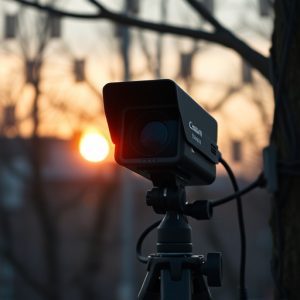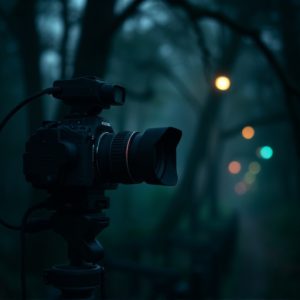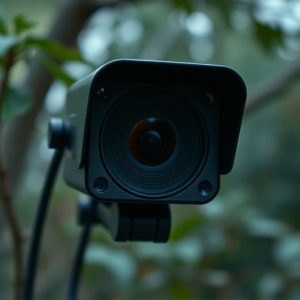Uncover Hidden Cameras: RF Detection Guide for Nanny Cam Spots
Hidden nanny cams utilize radio frequency (RF) technology for wireless video transmission, making th…….
Hidden nanny cams utilize radio frequency (RF) technology for wireless video transmission, making them undetectable by conventional methods. Understanding RF bands (2.4 GHz or 5 GHz) used by these devices is key to detection. Specialized RF detectors and scanners can uncover these signatures, offering essential Nanny Cam Placement Tips Home for households seeking privacy and security. This includes discreet placement in common and intimate areas, while balancing security with ethical considerations within legal boundaries.
Uncover hidden cameras in your home with our comprehensive guide on detecting radio frequency (RF) signals. Understanding the technology behind nanny cams is crucial for privacy protection. Learn about common placement spots, from closets to smoke detectors, and the tools needed to detect RF emissions. Our step-by-step process ensures you can safely and legally uncover any hidden surveillance devices. Additionally, we explore legal considerations and ethical use cases for RF detection techniques, empowering you with knowledge in today’s privacy-conscious world.
- Understanding Radio Frequency (RF) Technology in Hidden Cameras
- Common Nanny Cam Placement Spots in the Home
- Tools and Equipment for Detecting RF Signals
- Step-by-Step Guide to Uncovering Hidden Cameras Using RF Detection
- Legal Considerations and Ethical Use of RF Detection Techniques
Understanding Radio Frequency (RF) Technology in Hidden Cameras
Hidden cameras, often referred to as nanny cams, utilize radio frequency (RF) technology to transmit video signals wirelessly for remote monitoring. Understanding RF technology is crucial when it comes to detecting these hidden devices. RF works by transmitting data through electromagnetic waves, allowing cameras to send footage discreetly over short or long distances. These waves can be manipulated and tailored to carry specific frequencies, making them hard to detect with conventional means.
Knowing the RF spectrum and how nanny cams operate is a valuable Nanny Cam Placement Tips Home. These devices typically emit signals in the 2.4 GHz or 5 GHz bands, which are commonly used for wireless networking. By using specialized detectors or frequency scanners, one can identify these RF signatures, helping to uncover hidden cameras and ensure privacy and security within homes.
Common Nanny Cam Placement Spots in the Home
Many homeowners install hidden cameras, commonly known as nanny cams, in strategic locations throughout their homes for security and peace of mind. When it comes to placement, there are several common areas where these devices are frequently set up. For instance, kitchens and bathrooms often feature high on the list due to their vulnerability to break-ins or intimate moments that require monitoring.
Bedrooms are another popular choice for nanny cam placement tips home users, as they offer a sense of security while ensuring privacy. Hallways, living rooms, and even offices within the home can also be equipped with these devices, providing a comprehensive security network. The key to effective nanny cam placement is discretion, ensuring that the cameras remain hidden yet cover all potential entry points or areas of concern.
Tools and Equipment for Detecting RF Signals
Detecting hidden cameras using radio frequency (RF) signals requires specific tools and equipment to ensure accuracy and safety. Start with a high-sensitivity RF detector, capable of picking up even faint signals. These devices often come with adjustable frequency ranges, allowing you to narrow down and identify the unique RF signature of many hidden cameras, including nanny cams commonly placed in homes.
Additionally, consider investing in an RF signal generator for more advanced analysis. This tool can help you scan and map out RF interference, pinpointing exact locations where devices are transmitting data. Together with a good pair of headphones and a notepad for recording readings, these instruments empower you to follow nanny cam placement tips home by identifying potential hidden cameras discreetly and effectively.
Step-by-Step Guide to Uncovering Hidden Cameras Using RF Detection
Uncovering hidden cameras using radio frequency (RF) detection is a valuable skill for anyone concerned about privacy in their home or workplace. Here’s a step-by-step guide to help you identify covert surveillance devices:
1. Understand RF Signals: Hidden cameras often transmit video and audio data wirelessly, making them detectable through RF signals. Familiarize yourself with common RF bands used by nanny cams, such as 2.4 GHz and 5.8 GHz.
2. Acquire an RF Detector: Invest in a high-quality RF detector designed for locating wireless devices. These tools can pinpoint the exact frequency of transmissions, aiding in identifying suspicious signals.
3. Scan Your Environment: Begin scanning your home or office from room to room. Move the detector slowly across walls, furniture, and potential hiding spots where a nanny cam might be placed. Pay attention to areas like closets, behind pictures, or under surfaces that could conceal a camera.
4. Identify Anomalies: The RF detector will show readings on its display. Any sudden spikes in signal strength or unique frequency patterns could indicate an active hidden camera. Take note of these anomalies and investigate further.
5. Narrow Down the Location: Once you’ve identified suspicious signals, isolate the area. Check for multiple detections from different devices to confirm a hidden camera’s presence. Using your knowledge of common nanny cam placement tips for homes, carefully search the suspect areas without disturbing any potential evidence.
Legal Considerations and Ethical Use of RF Detection Techniques
When employing radio frequency (RF) detection techniques to uncover hidden cameras, it’s paramount to navigate the legal landscape and uphold ethical practices. The use of such technology must adhere to privacy laws and regulations in your jurisdiction. Unlawful surveillance is a serious breach of civil liberties, and individuals have the right to expect privacy in their homes, especially when it comes to Nanny Cam Placement Tips for home security.
Ethical considerations demand that RF detection be used responsibly and with legitimate reasons. It should not be employed as a means of invasive monitoring without consent. Professionals and individuals alike must ensure they are operating within legal boundaries, respecting the privacy rights of others, and only utilizing these techniques when necessary for safety or security purposes.
Detecting hidden cameras using radio frequency (RF) technology is a valuable skill for ensuring privacy in your home. By understanding how RF works in nanny cams, identifying common placement spots, and utilizing the right tools, you can take proactive steps to uncover any covert surveillance devices. The step-by-step guide provided offers a practical approach to detecting RF signals, but it’s crucial to navigate legal boundaries and employ these techniques ethically. Stay vigilant, stay informed, and protect your home from unwanted peepholes in the digital age.


